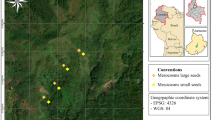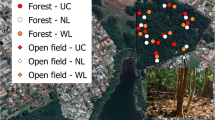Abstract
Seeds dispersed by tropical, arboreal mammals are usually deposited singly and without dung or in clumps of fecal material. After dispersal through defecation by mammals, most seeds are secondarily dispersed by dung beetles or consumed by rodents. These post-dispersal, plant-animal interactions are likely to interact themselves, as seeds buried by dung beetles are less likely to be found by rodents than unburied seeds. In a series of three experiments with seeds of 15 species in central Amazonia (Brazil), we determined (1) how presence and amount of dung associated with seeds influences long-term seed fate and seedling establishment, (2) how deeply dung beetles bury seeds and how burial depth affects seedling establishment, and (3) how seed size affects the interaction between seeds, dung beetles, and rodents. Our overall goal was to understand how post-dispersal plant-animal interactions determine the link between primary seed dispersal and seedling establishment. On average, 43% of seeds surrounded by dung were buried by dung beetles, compared to 0% of seeds not surrounded by dung (n=2,156). Seeds in dung, however, tended to be more prone than bare seeds to predation by rodents. Of seeds in dung, probability of burial was negatively related to seed size and positively related to amount of dung. Burial of seeds decreased the probability of seed predation by rodents three-fold, and increased the probability of seedling establishment two-fold. Mean burial depth was 4 cm (0.5–20 cm) and was not related to seed size, contrary to previous studies. Probability of seedling establishment was negatively correlated with burial depth and not related to seed size at 5 or 10 cm depths. These results illustrate a complex web of interactions among dung beetles, rodents, and dispersed seeds. These interactions affect the probability of seedling establishment and are themselves strongly tied to how seeds are deposited by primary dispersers. More generally, our results emphasize the importance of looking beyond a single type of plant-animal interaction (e.g., seed dispersal or seed predation) to incorporate potential effects of interacting interactions.




Similar content being viewed by others
References
Andresen E (1999) Seed dispersal by monkeys and the fate of dispersed seeds in a Peruvian rain forest. Biotropica 31:145–158
Andresen E (2001) Effects of dung presence, dung amount, and secondary dispersal by dung beetles on the fate of Micropholis guyanensis (Sapotaceae) seeds in Central Amazonia. J Trop Ecol 17:61–78
Andresen E (2002a) Dung beetles in a Central Amazonian rain forest and their ecological role as secondary seed dispersers. Ecol Entomol 27:257–270
Andresen E (2002b) Primary seed dispersal by red howler monkeys and the effect of defecation pattern on the fate of dispersed seeds. Biotropica 34:261–272
Andresen E (2003) Effect of forest fragmentation on dung beetle communities and functional consequences for plant regeneration. Ecography 26:87–97
Bronstein JL (2001) The costs of mutualisms. Am Zool 41:825–839
Chambers JC, MacMahon JA (1994) A day in the life of a seed: movements and fates of seeds and their implications for natural and managed systems. Annu Rev Ecol Syst 25:263–292
Crawley M (1993) GLIM for ecologists. Blackwell Scientific, Oxford
Crawley M (2000) Seed predators and plant population dynamics. In: Fenner M (ed) Seeds: the ecology of regeneration in plant communities. CAB International, Wallingford, pp 167–182
Dalling JW, Swaine MD, Garwood NC (1994) Effect of soil depth on seedling emergence in tropical soil seed-bank investigations. Funct Ecol 9: 119–121
Doube BM (1990) A functional classification analysis of the structure of dung beetle assemblages. Ecol Entomol 15:371–383
Estrada A, Coates-Estrada R (1991) Howler monkeys (Alouatta palliata), dung beetles (Scarabaeidae) and seed dispersal: ecological interactions in the tropical rain forest of Los Tuxtlas, Mexico. J Trop Ecol 7:459–474
Estrada A, Halffter G, Coates-Estrada R, Merritt D Jr (1993) Dung beetles attracted to mammalian herbivore (Alouatta palliata) and omnivore (Nasua narica) dung in the tropical rain forest of Los Tuxtlas, Mexico. J Trop Ecol 9:45–54
Feer F (1999) Effect of dung beetles (Scarabaeidae) on seeds dispersed by howler monkeys (Alouatta seniculus) in the French Guianan rain forest. J Trop Ecol 15:129–142
Fenner M (1987) Seedlings. New Phytol 106(Supplement):35–47
Francis B, Green M, Payne C (1993) The GLIM system: Release 4, Manual. Clarendon, Oxford
Gill B (1991). Dung beetles in tropical American forests. In: Hanski I, Cambefort Y (eds) Dung beetle ecology. Princeton University Press, Princeton, New Jersey, pp 211–229
Halffter G, Edmonds WD (1982) The nesting behavior of dung beetles (Scarabaeinae). An ecological and evolutive approach. Instituto de Ecologia, Mexico D.F.
Hanski I, Cambefort Y (1991) Dung beetle ecology. Princeton University Press, Princeton, New Jersey
Harms KE, Wright SJ, Calderon O, Hernandez A, Herre EA (2000) Pervasive density-dependent recruitment enhances seedling diversity in a tropical forest. Nature 404:493–495
Herrera CM (2000) Measuring the effects of pollinators and herbivores: evidence for non-additivity in a perennial herb. Ecology 81:2170–2176
Herrera CM, Pellmyr O (2002) Plant-animal interactions: an evolutionary approach. Blackwell, Oxford
Herrera CM, Jordano P, Lopez-Soria L, Amat JA (1994) Recruitment of a mast-fruiting, bird-dispersed tree: bridging frugivore activity and seedling establishment. Ecol Monogr 64:315–344
Holdridge LR (1967) Life zone ecology. Tropical Science Center, San José, Costa Rica
Howe HF, Miriti MN. 2000. No question: seed dispersal matters. Trends Ecol Evol 15:434–436
Howe HF, Smallwood J (1982) Ecology of seed dispersal. Annu Rev Ecol Syst 13:201–228
Hulme PE, Benkman CW (2002) Granivory. In: Herrera C, Pellmyr O (eds) Plant-animal interactions: an evolutionary approach. Blackwell Scientific, New York, pp 132–154
Janzen DH (1971) Seed predation by animals. Annu Rev Ecol Syst 2:465–492
Janzen DH (1982a) Attraction of Liomys mice to horse dung and the extinction of this response. Anim Behav 30:483–489
Janzen DH (1982b) Removal of seeds from horse dung by tropical rodents: influence of habitat and amount of dung. Ecology 63:1887–1900
Jordano P, Herrera CM (1995) Shuffling the offspring: uncoupling and spatial discordance of multiple stages in vertebrate seed dispersal. Ecoscience 2:230–237
Jules ES, Rathcke BJ (1999) Mechanisms of reduced Trillium recruitment along edges of old-growth forest fragments. Conserv Biol 13:784–793
Lambert JE (2002) Exploring the link between animal frugivory and plant strategies: the case of primate fruit processing and post-dispersal seed fate. In: Levey DJ, Silva WR, Galetti, M (eds) Seed dispersal and frugivory: ecology, evolution and conservation. CABI, Oxon, pp 365–379
Leishman MR, Wright IJ, Moles AT, Westoby M (2000) The evolutionary ecology of seed size. In: Fenner M (ed) Seeds: the ecology of regeneration in plant communities. CABI, Oxon, pp 31–57
Lovejoy TE, Bierregaard RO (1990) Central Amazonian forests and the Minimum Critical Size of Ecosystems Project. In: Gentry A (ed) Four neotropical rainforests. Yale University Press, New Haven, Connecticut, pp 60–71
Malcolm JR (1990) Estimation of mammalian densities in continuous forest north of Manaus. In: Gentry A (ed) Four Neotropical rainforests. Yale University Press, New Haven, Connecticut, pp 339–357
Mittal IC (1993) Natural manuring and soil conditioning by dung beetles. Trop Ecol 34:150–159
Pearson TRH, Burslem DFRP, Mullins CE, Dalling JW (2002) Germination ecology of Neotropical pioneers: interacting effects of environmental conditions and seed size. Ecology 83:2798–2807
Peck SB, Howden HF (1984) Response of a dung beetle guild to different sizes of dung bait in a Panamanian rainforest. Biotropica 16:235–238
Schupp EW (1995) Seed-seedling conflicts, habitat choice, and patterns of plant recruitment. Am J Bot 82:399–409
Shepherd VE, Chapman CA (1998) Dung beetles as secondary seed dispersers: impact on seed predation and germination. J Trop Ecol 14:19–215
Sokal RR, Rohlf FJ (1995) Biometry. WH Freeman, New York
SPSS Inc (1996) Systat 6.0. SPSS, Chicago, Illinois
Steffan-Dewenter I, Munzenberg U, Tscharntke T (2001) Pollination, seed set, and seed predation in a landscape scale. Proc R Soc London Biol Sci 268:1685–1690
Strauss SY, Armbruster WS (1997) Linking herbivory and pollination—new perspectives on plant and animal ecology and evolution. Ecology 78:1617–1618
Terborgh J (1986) Community aspects of frugivory in tropical forests. In: Estrada A, Fleming TH (eds) Frugivores and seed dispersal. Junk, Dordrecht, pp 371–384
Vander Wall SB (2001) The evolutionary ecology of nut dispersal. Bot Rev 67:74–117
Vulinec K (2002) Dung beetle communities and seed dispersal in primary forest and disturbed land in Amazonia. Biotropica 34:297–309
Wang BC, Smith TB (2002) Closing the seed dispersal loop. Trends Ecol Evol 17:379–385
Wenny DG (2000) Seed dispersal, seed predation, and seedling recruitment of a Neotropical montane tree. Ecol Monogr 70:3391–351
Acknowledgements
We thank R. Bodmer, J. Brockmann, C. Chapman, F. Putz, T. Theimer, and three anonymous reviewers for comments on the manuscript. Financial and logistic support were provided by the Department of Zoology and College of Liberal Arts and Sciences at the University of Florida, the Biological Dynamics of Forest Fragments Project, Instituto Nacional de Pesquisas da Amazônia (INPA), Smithsonian Institution, Lincoln Park Zoo, and Wildlife Conservation Society. All experiments in this study comply with current Brazilian laws. This is contribution number 419 in the INPA-Smithsonian-BDFFP technical series.
Author information
Authors and Affiliations
Corresponding author
Rights and permissions
About this article
Cite this article
Andresen, E., Levey, D.J. Effects of dung and seed size on secondary dispersal, seed predation, and seedling establishment of rain forest trees. Oecologia 139, 45–54 (2004). https://doi.org/10.1007/s00442-003-1480-4
Received:
Accepted:
Published:
Issue Date:
DOI: https://doi.org/10.1007/s00442-003-1480-4




